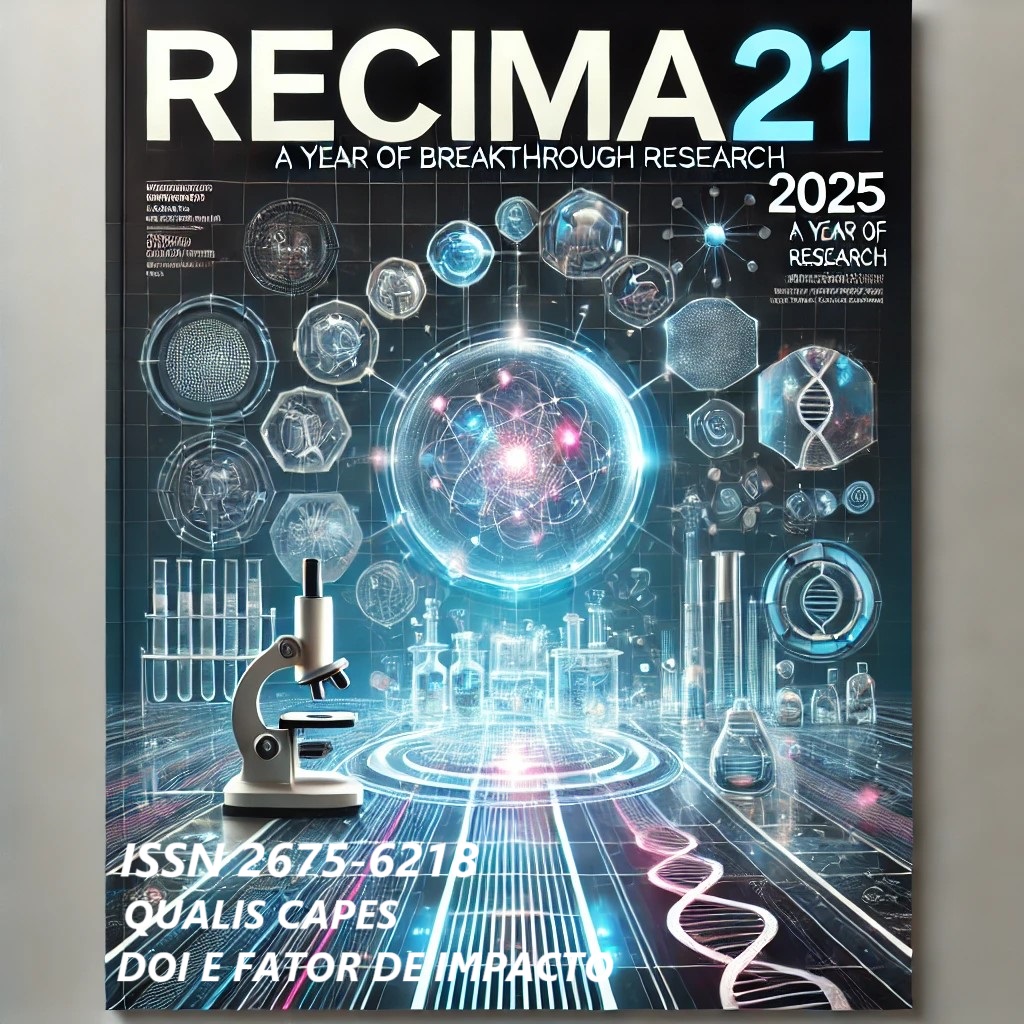DESARROLLO DE PRÓTESIS: UNA REVISIÓN SISTEMÁTICA DE LA LITERATURA
DOI:
https://doi.org/10.47820/recima21.v6i8.6692Palabras clave:
Prótesis, AI, Tecnología, Evolución, RSLResumen
La tecnología es indispensable en muchas áreas, como la ingeniería, la educación y la salud. En el ámbito de la salud, la creación de prótesis ha alcanzado avances significativos. Por lo tanto, para comprender cómo se desarrollan las tecnologías y los desafíos que enfrentan los investigadores, este trabajo propone realizar una Revisión Sistemática de la Literatura (RSL) con cinco Preguntas de Investigación (PIs): PI1 – ¿Cuáles son los principales avances tecnológicos en el desarrollo de prótesis en los últimos 10 años? PI2 – ¿Qué materiales y técnicas innovadoras se han incorporado a las prótesis para mejorar su funcionalidad y comodidad? PI3 – ¿Cómo ha impactado la integración de la IA y la neurotecnología en el rendimiento de las prótesis? PI4 – ¿Cuáles son los principales desafíos enfrentados en el desarrollo y la accesibilidad de las prótesis modernas? PI5 – ¿Qué evidencias científicas indican mejoras en la calidad de vida de los usuarios de prótesis avanzadas? Los resultados de la RSL mostraron avances (PI1), como el uso de la impresión 3D y las prótesis mioeléctricas. Además, destacaron técnicas y materiales (PI2) que emplean sensores, técnicas de compuestos y grafeno. También se observó el uso de IA y neurotecnología (PI3), promoviendo integraciones entre tecnologías para entrenar algoritmos. En cuanto a las dificultades (PI4), los principales motivos incluyen discrepancias entre la simulación y la aplicación real, así como riesgos para el paciente.
Descargas
Referencias
ANWAR, Adeel et al. Artificial intelligence technology improves the accuracy of preoperative planning in primary total hip arthroplasty. Asian Journal of Surgery, v. 47, n. 7, p. 2999-3006, 2024. DOI: https://doi.org/10.1016/j.asjsur.2024.01.133
BIONICENTER. Bionicenter - Excelência em Próteses Biônicas e Órteses. [S. l]: Bionicenter, 2025. Disponível em: https://bionicenter.com.br/. Acesso em: 19 jul. 2025.
BRASIL. Laboratório de Tecnologia Assistiva e Inclusão (LATAI). Brasília: INT, 2025. Disponível em: https://www.gov.br/int/pt-br/pesquisa-desenvolvimento/design-industrial/laboratorio-de-tecnologia-assistiva-e-inclusao-latai. Acesso em: 19 jul. 2025.
CALADO, Alexandre et al. A geometric algebra-based approach for myoelectric pattern recognition control and faster prosthesis recalibration. Expert Systems with Applications, v. 254, p. 124373, 2024. 30 abr. 2025. DOI: https://doi.org/10.1016/j.eswa.2024.124373
CAO, Wujing et al. Design and evaluation of a novel microprocessor-controlled prosthetic knee. IEEE Access, v. 7, p. 178553-178562, 2019. DOI: https://doi.org/10.1109/ACCESS.2019.2957823
CHAPPELL, Digby et al. Beyond Humanoid Prosthetic Hands: Modular Terminal Devices That Improve User Performance. IEEE Transactions on Neural Systems and Rehabilitation Engineering, 2025. DOI: https://doi.org/10.1109/TNSRE.2025.3528725
CHAVES, Gabriel S.; VIEIRA, Anderson S.; LIMA, Markus VS. sEMG-Based Gesture Classifier Through DTW and Enhanced Muscle Activity Detection. IEEE Access, 2024. DOI: https://doi.org/10.1109/ACCESS.2024.3448410
CHEN, Yawei et al. Modeling and control of knee-ankle-toe active transfemoral prosthesis. IEEE Access, v. 8, p. 133451-133462, 2020. DOI: https://doi.org/10.1109/ACCESS.2020.3010636
CUTIPA-PUMA, Diego Ronaldo; COAGUILA-QUISPE, Cristian Giovanni; YANYACHI, Pablo Raul. A low-cost robotic hand prosthesis with apparent haptic sense controlled by electroencephalographic signals. HardwareX, v. 14, p. e00439, 2023. DOI: https://doi.org/10.1016/j.ohx.2023.e00439
DICIO. Prótese. [S. l.]: Dicio, 2025. Disponível em: https://www.dicio.com.br/protese/. Acesso em: 19 jul. 2025.
EVCI, Furkan; SAROGLU, Yavuz; KONUKSEVEN, Erhan Ilhan. Gait Recognition and Phase Detection Using WearableIMUSensorsand Neural Network Algorithms. In: Proceedings of the 2023 7th international conference on advances in artificial intelligence. 2023. p. 138-143. DOI: https://doi.org/10.1145/3633598.3633620
FAY, J. Contemporary security management. [S. l.]: Elsevier, 2010. DOI: https://doi.org/10.1016/B978-0-12-381549-1.00007-5
FOULY, Ahmed et al. Developing artificial intelligence models for predicting the tribo-mechanical properties of HDPE nanocomposite used in artificial hip joints. IEEE Access, v. 12, p. 14787-14799, 2024. DOI: https://doi.org/10.1109/ACCESS.2024.3352448
GOOGLECLOUD. O que é inteligência artificial (IA)? [S. l.]: Googlecloud, 2025. Disponível em: https://cloud.google.com/learn/what-is-artificial-intelligence?hl=pt-BR. Acesso em: 19 jul. 2025.
GUAN, Bonnie et al. Offline vs Real-time Grasp Prediction Employing a Wearable High-Density Lightmyography Armband: On the Control of Prosthetic Hands. IEEE Access, 2025. DOI: https://doi.org/10.1109/ACCESS.2025.3556920
HAN, N.; SRIVASTAVA, S.; XU, A.; KLEIN, D.; BEYELER, M. Deep learning–based scene simplification for bionic vision. In: Proceedings of the Augmented Humans International Conference, p. 45-54, 2021. DOI: https://doi.org/10.1145/3458709.3458982
HE, Yunan et al. Development of distributed control system for vision-based myoelectric prosthetic hand. IEEE Access, v. 7, p. 54542-54549, 2019. DOI: https://doi.org/10.1109/ACCESS.2019.2911968
HE, Yunan et al. Vision-based assistance for myoelectric hand control. IEEE Access, v. 8, p. 201956-201965, 2020. DOI: https://doi.org/10.1109/ACCESS.2020.3036115
HERNÁNDEZ-LARA, Derlis et al. Optimal design of a foot prosthesis insole with composite materials applying metaheuristic algorithms. Results in Engineering, v. 13, p. 100322, 2022. DOI: https://doi.org/10.1016/j.rineng.2021.100322
HIGGINS, E.; EASLEY, W. B.; GORDES, K. L.; HURST, A.; HAMIDI, F. Creating 3D Printed Assistive Technology Through Design Shortcuts: Leveraging Digital Fabrication Services to Incorporate 3D Printing into the Physical Therapy Classroom: Leveraging Digital Fabrication Services to Incorporate 3D Printing into the Physical Therapy Classroom. In: Proceedings of the 24th International ACM SIGACCESS Conference on Computers and Accessibility, p. 1-16, 2022. DOI: https://doi.org/10.1145/3517428.3544816
KASOWSKI, Justin; BEYELER, Michael. Immersive virtual reality simulations of bionic vision. In: Proceedings of the Augmented Humans International Conference 2022, p. 82-93, 2022. DOI: https://doi.org/10.1145/3519391.3522752
KAUFMAN, Dora. Desmistificando a inteligência artificial. São Paulo: Autêntica Editora, 2022.
KITCHENHAM, B. Procedures for performing systematic reviews. Keele, UK, Keele University, v. 33, n. 2004, p. 1-26, 2004.
LEMES, Marcellle Martins; LEMOS, Amanda Nunes Lopes Espiñeira. O uso da inteligência artificial na saúde pela Administração Pública brasileira. Cadernos Ibero-Americanos de Direito Sanitário, v. 9, n. 3, p. 166-182, 2020. DOI: https://doi.org/10.17566/ciads.v9i3.684
MASTINU, E. et al. Explorations of autonomous prosthetic grasping via proximity vision and deep learning. IEEE Transactions on Medical Robotics and Bionics, v. 6, n. 2, p. 685-694, 2024. DOI: https://doi.org/10.1109/TMRB.2024.3377530
MAZUMDER, Aniket; HEKMAN, Edsko EG; CARLONI, Raffaella. An adaptive hybrid control architecture for an active transfemoral prosthesis. IEEE Access, v. 10, p. 52008-52019, 2022. DOI: https://doi.org/10.1109/ACCESS.2022.3173348
MAZUMDER, Aniket; HEKMAN, Edsko EG; CARLONI, Raffaella. Toward controlling transtibial prostheses using a single degree of freedom inertial sensor system. IEEE Access, v. 12, p. 24803-24812, 2024. DOI: https://doi.org/10.1109/ACCESS.2024.3364498
NSUGBE, Ejay. On optimal and varying decompositions for transradial contraction force prediction in upper-limb prosthesis. Intelligent Systems with Applications, v. 16, p. 200134, 2022. DOI: https://doi.org/10.1016/j.iswa.2022.200134
OLIVEIRA, Felipe Proenço de et al. Confecção e manutenção de órteses, próteses e meios auxiliares de locomoção: confecção e manutenção de próteses de membros inferiores, órteses suropodálicas e adequação postural em cadeira de rodas. In: Confecção e manutenção de órteses, próteses e meios auxiliares de locomoção: confecção e manutenção de próteses de membros inferiores, órteses suropodálicas e adequação postural em cadeira de rodas, p. 224, 2013.
PROTETICS. Protetics - Como funcionam as próteses biônicas. [S. l.]: PROTETICS, 2022. Disponível em: https://www.protetics.com.br/como-funcionam-as-proteses-bionicas. Acesso em: 19 jul. 2025.
QUEIROZ, William Fernandes de. Desenvolvimento de métodos construtivos e de novos materiais empregados na confecção de cartuchos de próteses de membros inferiores. 2008. 155 f. Tese (Doutorado em Tecnologia de Materiais; Projetos Mecânicos; Termociências) - Universidade Federal do Rio Grande do Norte, Natal, 2008.
RASLA, A.; BEYELER, M.. The relative importance of depth cues and semantic edges for indoor mobility using simulated prosthetic vision in immersive virtual reality. In: Proceedings of the 28th ACM symposium on virtual reality software and technology, p. 1-11. 2022. DOI: https://doi.org/10.1145/3562939.3565620
RODRIGUES JÚNIOR, J. L.; CRUZ, L. M. DE S.; SARMANHO, A. P. S. Impressora 3D no desenvolvimento de pesquisas com próteses. Revista Interinstitucional Brasileira de Terapia Ocupacional-REVISBRATO, v. 2, n. 2, p. 398-413, 2018. DOI: https://doi.org/10.47222/2526-3544.rbto15022
RUECKAUER, B.; VAN GERVEN, M.. Experiencing prosthetic vision with event-based sensors. In: Proceedings of the International Conference on Neuromorphic Systems, p. 1-7. 2022. DOI: https://doi.org/10.1145/3546790.3546813
RUIZ-SERRA, Jaime et al. Learning scene representations for human-assistive displays using self-attention networks. ACM Transactions on Multimedia Computing, Communications and Applications, v. 20, n. 7, p. 1-26, 2024. DOI: https://doi.org/10.1145/3650111
SOUZA, Gabriel Cirac M.; MORENO, Robson L.; PIMENTA, Tales C. Pattern recognition in myoelectric signals using deep learning, features engineering, and a graphics processing unit. IEEE Access, v. 8, p. 208952-208960, 2020. DOI: https://doi.org/10.1109/ACCESS.2020.3038992
SOUZA, Gabriel Cirac Mendes; MORENO, Robson Luiz. Netlab MLP-Performance Evaluation for Pattern Recognition in Myoletric Signal. Procedia Computer Science, v. 130, p. 932-938, 2018. DOI: https://doi.org/10.1016/j.procs.2018.04.092
SUGIURA, Sojiro et al. Passive lower limb exoskeleton for kneeling and postural transition assistance with expanded support polygon. IEEE/ASME Transactions on Mechatronics, v. 29, n. 2, p. 1193-1204, 2023. DOI: https://doi.org/10.1109/TMECH.2023.3294255
SUN, Yinghe et al. A comparison between virtual reality and augmented reality on upper-limb prosthesis control. In: 2021 International Symposium on Electrical, Electronics and Information Engineering, p. 521-528, 2021. DOI: https://doi.org/10.1145/3459104.3459189
TEIXEIRA, Pedro; VALLE, Silvio (Ed.). Biossegurança: uma abordagem multidisciplinar. Rio de Janeiro: Editora FIOCRUZ, 2010. DOI: https://doi.org/10.7476/9788575413067
THOMAS, Neha et al. The utility of synthetic reflexes and haptic feedback for upper-limb prostheses in a dexterous task without direct vision. IEEE Transactions on Neural Systems and Rehabilitation Engineering, v. 31, p. 169-179, 2022. DOI: https://doi.org/10.1109/TNSRE.2022.3217452
ZHANG, Gang et al. The advantages of artificial intelligence-assisted total hip arthroplasty: a randomized controlled trial followed by 12 months. Heliyon, v. 10, n. 22, 2024. DOI: https://doi.org/10.1016/j.heliyon.2024.e39664
Descargas
Publicado
Licencia
Derechos de autor 2025 RECIMA21 - Revista Científica Multidisciplinar - ISSN 2675-6218

Esta obra está bajo una licencia internacional Creative Commons Atribución 4.0.
Os direitos autorais dos artigos/resenhas/TCCs publicados pertecem à revista RECIMA21, e seguem o padrão Creative Commons (CC BY 4.0), permitindo a cópia ou reprodução, desde que cite a fonte e respeite os direitos dos autores e contenham menção aos mesmos nos créditos. Toda e qualquer obra publicada na revista, seu conteúdo é de responsabilidade dos autores, cabendo a RECIMA21 apenas ser o veículo de divulgação, seguindo os padrões nacionais e internacionais de publicação.













